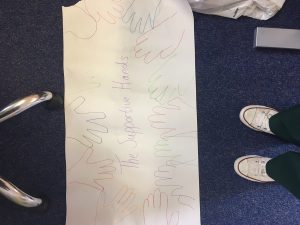What is Wellbeing?
Brown and Brown (2004) illuminate how the quality of life and wellbeing is completely unique and individual from person to person. It appears very difficult to define the quality of life as one unitary concept as there are multiple elements and domains which contribute to it. Mind describes mental wellbeing as your “mental state – how you are feeling and how well you can cope with day-to-day life.
Our mental wellbeing is dynamic. It can change from moment to moment, day to day, month to month or year to year.
If you have good mental wellbeing you are able to:
- feel relatively confident in yourself and have positive self-esteem
- feel and express a range of emotions
- build and maintain good relationships with others
- feel engaged with the world around you
- live and work productively
- cope with the stresses of daily life
- adapt and manage in times of change and uncertainty”
How to improve your wellbeing
Below are five things that the NHS suggest, according to research, can really help to boost our mental wellbeing:
- Connect
- Be active
- Keep learning
- Give to others
- Be mindful
Improving Wellbeing at Inspirative Arts
We use creativity in person-centred way to improve wellbeing. We use a method similar to that of Rogers’ (1993:2) idea of creative arts therapies which uses “various arts- movement, drawing painting, sculpting, music, sound, and improvisation- in a supportive setting to facilitate growth and healing.” Winnicott (1971) suggested that if individuals do not live creatively then there is not much worth to life. Creativity has been seen as a basic healing drive that has the potential to enhance quality of life for people (Jung, 1990).
Here is an example of a recent workshop which empowered clients to think about their own well-being.
We asked the clients “what does wellbeing mean to you?” The clients enjoyed connecting, sharing and communicating with one another as they discussed all the things that made them feel happy. They shared a wide variety of things, many themes included:
- Socialising
- Family
- Friends
- Relaxing
- Learning
- Family
- Choice
- Freedom
- Independence
- Sense of Identity
- Culture
- Religion
- Pets
They created a heart of all the things that improved their mental wellbeing and made them feel happy. They decided to call it ‘Inspirative Heart”.
We picked out a few themes from the heart and explored this through movement with a large resistance band which was made into a circle. Every individual held onto the band which enabled them to feel connected to the rest of the group even if they did not want to take an active lead. The individuals had a choice in the music that was played and was free to express themselves and dance to the music. One client chose to dress up which enabled her to feel more relaxed and comfortable to join in. Individuals developed their confidence as they took and turned to choose movements, lead the group as the rest of the group mirrored their movements. They felt supported as the resistance band held them and guided them in a safe and contained way. They used the band to explore tension in relationships and resolve arguments.
After the movement we reflected on how they felt after the activity, they all said how they enjoyed coming and feeling connected to others so we picked out this theme and created a piece of art to reflect this and bring closure to the workshop.
Facilitator


What we have found
We found that although wellbeing has many varying factors and is person to each individual, there was common theme of connection which seemed to enhance everyone’s wellbeing, this is also in-line with the NHS’s advice. We used music, movement and art to explore this theme further, which in turn enabled the group to feel more connected and in-turn enhance their wellbeing.
Holden and Woods (1995), state that our identities are constantly furthered and developed as we move through different groups throughout our lives and feel a connection with others. Even in our most solitary moment’s creativity is a group process of interacting forces, images, ideas and possibilities, all gathering together to make something that is shaped from the unique qualities of relationship to one another (McNiff, 2004). Hayes (2011:35) believes that “creativity enhances relationships. Group creativity can encourage social responses and relationships..” Using creativity in this session allowed individuals to connect with one-another and therefore improve their wellbeing.
Keep your eyes peeled to read our next blog post which explored the importance of self-care and wellbeing for parents, carers and people working in the social sector.
References
Brown, I. & Brown, R. (2004).Quality of Life and Disability: An Approach for Community Practitioners. London: Jessica Kingsley Publishers.
Hayes, J. (2011). The Creative Arts in Dementia Care. London: Jessica Kingsley Publishers.
Holden, U. & Woods, R. (1995) Positive Approaches to Dementia Care. 3rd edn. Edinburgh: Churchill Livingstone, Pearson Professional Limited.
Jung, C. (1990) Memories, Dreams, Reflections. London: Fontana Paperbacks.
McNiff, S. (2004) Art Heals: How Creativity Cures the Soul. Boston: Shambhala Publications.
Rogers, N. (1993). The Creative Connection: Expressive arts as healing. Palo Alto, CA: Science and Behavior Books.
Winnicott, D. (1971) Playing and Reality. London: Tavistock Publications Limited.



